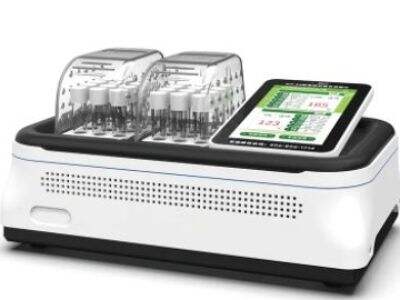Jadi, selamat datang ke dunia yang menakjubkan sains. Kami juga menggunakan alat ini yang dipanggil spektrofotometer di makmal. Kerana mengukur cahaya tidaklah mudah dan alat-alat ini membuatnya lebih mudah, mereka sangat bernilai. Banyak eksperimen melibatkan pengukuran cahaya, dan pengukuran ini memberitahu kita lebih banyak tentang bahan-bahan dan substans yang berbeza. Tetapi, untuk memastikan kita mendapat hasil yang baik dan tepat, spektrofotometer mesti diselaraskan. Penyelarasan adalah seperti pemeriksaan kesihatan untuk spektrofotometer — sama ada kita pergi ke doktor untuk memastikan kita tidak sakit. Prosedur ini dikenali sebagai 'penyelarasan', yang menjamin bahawa alat itu berfungsi dengan betul dan memberi kita bacaan yang terbaik.
Bagaimana Anda Boleh Menyelaras Spektrofotometer?
Penyesuaian sebuah spektrofotometer kelihatan agak menakutkan pada permulaan tetapi setelah anda terbiasa, prosesnya adalah cukup mudah! Jadi, anda perlu hidupkan spektrofotometer dahulu dan biarkan ia memanas selama beberapa masa. Ini sangat penting kerana ia menyediakan peranti untuk mengambil ukuran yang betul. Pertama, kita pilih sampel—setelah ia telah dipanaskan—and sampel itu kosong. Sampel kosong adalah seperti muka surat baru; ia digunakan untuk menolak instrument kepada sifar. Proses ini membolehkan kita menyaring sebarang bunyi latar belakang atau ralat yang mungkin mempengaruhi bacaan kita. Jadi kita mendapat kertas kosong apabila kita ingin menulis sesuatu.
Selepas menyelaraskan alat dengan sampel kosong pada sifar, sampel piawai boleh digunakan untuk penyelarasan. Ini adalah sampel piawai biasa, dengan nilai penyerapan yang dapat kita pastikan. Kami menggunakan sampel piawai ini untuk menyelaraskan spektrofotometer untuk memastikan ia mengukur cahaya dengan betul. Ianya agak seperti menggunakan berat yang diketahui untuk memeriksa bahawa skala penimbang sebenarnya adalah betul. Ini membuktikan bahawa berat itu membantu menyeimbangkan skala dan oleh itu boleh digunakan untuk mengesan sama ada skala berfungsi secara normal.
Tip untuk Pengukuran yang Baik
Terdapat beberapa tip utama yang perlu kita ingat untuk memastikan kita mendapatkan pengukuran yang baik dan boleh dikesan semula menggunakan spektrofotometer. Pertama, membersihkan alat adalah penting. Debu atau kotoran pada selle spektrofotometer mungkin mengubah bacaan dan memberikan hasil yang salah. Seperti jendela bersih membantu anda melihat dengan lebih baik, mempunyai alat yang penuh-mudah digunakan dan bersih membantu kami mendapatkan pengukuran yang lebih baik.
Seterusnya, sentiasa guna sampel berkualiti tinggi yang telah disediakan dengan betul untuk mana-mana eksperimen yang kita lakukan. Ini penting kerana jika beberapa sampel tidak murni atau mengandungi kotoran, ia akan mengganggu keputusan yang kita perolehi. Ia seperti memanggang kek; jika anda menggunakan bahan segar, kek anda akan terasa sedap, tetapi jika anda menggunakan bahan yang telah tamat tempoh, ia tidak akan sedap sama sekali!
Satu petua baik juga adalah mengambil lebih daripada satu pengukuran dan puratakan keputusan anda. Ini mempunyai kesan mengurangkan sebarang ralat atau perbezaan dalam bacaan. Jika kita mengukur sesuatu banyak kali, dan menjumlahkan serta mencari purata nombor-nombor itu, kita boleh lebih yakin bahawa keputusan kita adalah betul. Anda juga mesti menggunakan alatan yang sama (peranti pengukuran) dan tetapan yang sama sepenuhnya untuk setiap bacaan. Kepantasan inilah yang memastikan keputusan kita seragam dan hampir identik setiap kali kita menjalankan satu eksperimen.
Kesilapan Biasa yang Perlu Dielakkan
Jadi, mari cuba elakkan beberapa kesilapan biasa semasa menyesuaikan spektrofotometer. Salah satu kesilapan terbesar adalah tidak membiarkan alatan memanaskan diri cukup lama sebelum mengambil pengukuran. Seperti mencuba menjalankan perlumbaan tanpa pemanasan, jika kita melewatkan langkah ini, kita berisiko mendapat bacaan yang tidak tepat!
Masalah umum lainnya adalah gagal membersihkan alatan dengan betul sebelum digunakan. Sebarang kotoran atau debu pada pembacaan spektrometer boleh mempengaruhi hasil dan menyebabkan keputusan palsu. Sebelum kita mula mengukur, ia amat penting untuk memastikan alatan berfungsi dengan baik. Selain itu, sampel rujukan yang kita gunakan untuk penyesuaian juga perlu dikawal kualitinya dan tidak luput tempoh. Pengesanan sampel piawai berkualiti rendah atau telah tamat tempoh boleh menyebabkan ralat dalam hasil kami. Seperti menggunakan bahan-bahan lama dalam resepi, ia boleh mempengaruhi bagaimana produk akhir keluar!
Mendapatkan Keputusan Yang Boleh Dipercayai
Menggunakan spektrofotometer memerlukan teknik penyesuaian yang baik untuk mendapatkan keputusan yang boleh dikesan semula. Ini melibatkan memastikan bahawa alatan adalah bersih, menggunakan sampel berkualiti, dan menyusun alatan sebelum setiap penggunaan. Kepantasan adalah aspek yang paling kritikal apabila datang kepada mendapatkan keputusan yang tepat dan boleh dipercayai, oleh itu kita mesti memastikan kita mengikuti metodologi yang sama dengan setiap dan setiap eksperimen yang kita lakukan.
Secara keseluruhan, proses ini boleh menjadi baik menyeronokkan mahupun mencabar kepada saintis muda seperti diri anda! Penyesuaian boleh menjadi satu proses yang panjang, tetapi bagaimanapun, dengan mempraktikkan teknik penyesuaian yang betul dan mengetahui asas cara alat berfungsi, kita boleh mencapai kejituan dan meluaskan ilmu yang kita ada tentang spesimen tertentu. Berikut adalah pemahaman yang besar sehingga kini yang boleh membawa kepada penemuan yang mendebarkan secara saintifik! Produk makmal kami bertujuan untuk memberikan peralatan yang sempurna kepada saintis muda untuk menyiapkan eksperimen mereka. Selamat menjelajah dan menemui perkara baru dalam sains! Selamat membuat eksperimen!
 EN
EN
 AR
AR BG
BG CS
CS DA
DA NL
NL FR
FR DE
DE EL
EL HI
HI IT
IT JA
JA KO
KO PL
PL PT
PT RO
RO RU
RU ES
ES SV
SV CA
CA TL
TL IW
IW ID
ID SR
SR SK
SK VI
VI ET
ET HU
HU TH
TH TR
TR FA
FA AF
AF MS
MS GA
GA MK
MK BN
BN BS
BS LA
LA MN
MN NE
NE

